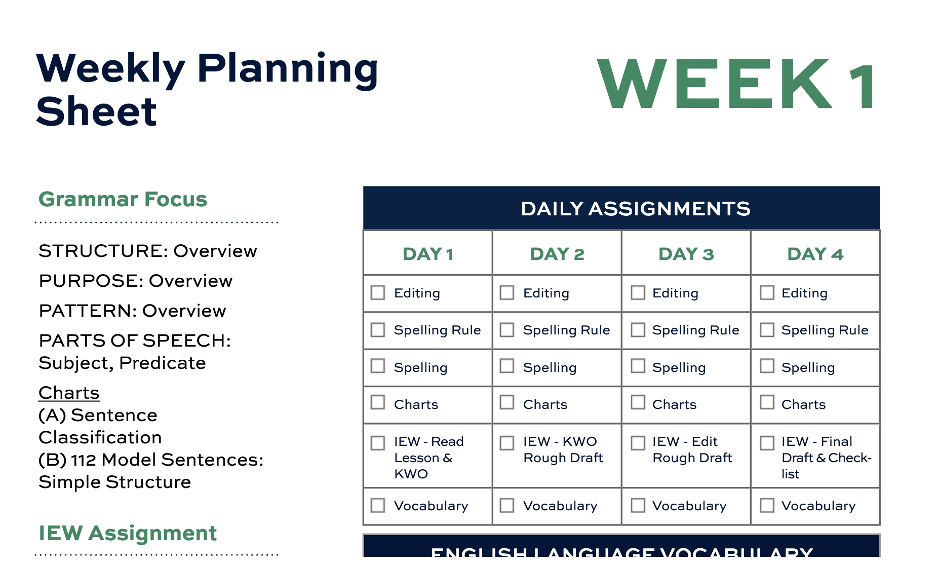If you’ve ever had your child ask, “Mom, how do you spell this word?”—you get it. Teaching your student how to spell can feel overwhelming, especially when trying to decide if memorizing word lists or learning spelling rules is the better approach. The good news? You don’t have to choose just one.
The Essentials program provides a structured yet flexible way to teach spelling by incorporating both spelling lists and spelling rules into grammar and writing exercises. This ensures students can memorize words and understand how spelling works in context.
In this article, we’ll explore how spelling lists help with 4th grade spelling words (or 5th or 6th grade spelling!), why spelling rules give students the tools to decode tricky words, and how you can use both to build your child’s confidence in spelling.
Let’s dive into practical strategies to make spelling lessons both effective and engaging.
The Easy Answer for Teaching Spelling
Children love to ask questions. They use them to get to know us better. Some of these questions can be difficult to answer. I have a hard time picking just one thing with questions like: What is your favorite? Would you rather? What is the best?
What’s your favorite food? Well, it depends. There are comfort foods that I could eat every day and certain sweets that I can’t pass up.
Would you rather visit the mountains or the beach? Yes, please!
What is the best approach to teaching spelling? Lists or Rules? This is an easy choice. The answer is BOTH!
Spelling Lists vs. Spelling Rules: Why Not Both?
In the article “Insights on Spelling” in the Essentials of the English Language Curriculum, Fifth Edition, Leigh Bortins suggests two key points for language learning:
- “Everyone should study basic phonics and spelling rules…” Spelling rules help students understand word patterns, phonics principles, and predictable letter combinations, giving them tools to decode and spell unfamiliar words.
- “Everyone should master the one thousand most commonly used words in over 90 percent of English.” Spelling lists focus on high-frequency words that appear often in writing and conversation but may not always follow standard spelling patterns.
This is why the Essentials Program offers two different approaches to spelling: Spelling Lists and Spelling Rules.
Both of these resources are found in the Essentials of the English Language Curriculum, Fifth Edition. They are referenced on the overview page for each week and in the At Home section of the weekly lesson. These skills your students develop at home will equip them to participate confidently in the Grammar and Composition discussions during Essentials in community.

How to Use Spelling Lists Effectively at Home
The simple lists from Susan Anthony’s Spelling Plus are incorporated into each week of the Essentials of the English Language Curriculum, Fifth Edition. You will find three list options at the end of each lesson. Students should be able to progress through the lists with each tour of Essentials.
For example, a first-tour student should choose List A and progress to the next list as they progress through the Essentials program.

Fun Spelling Memorization Techniques
The choices for helping your student to memorize the words are endless! As their teacher, you know your child best. You can tailor assignments to practice the skills of learning that fit their needs.
Here are a few ideas that I have using the Five Core Habits of Grammar. Choose some of these options or use the classical skills to create your own tools.
Naming
- State the words aloud, being sure to help your students pronounce them correctly.
- Use silly voices or voice inflection to add laughter to your study time.
- Play the Echo Game: whisper the word (or spell it out) in each other’s ear, then echo the word or spelling from across the room, the house, the yard, or down the street!
- Play Spelling Telephone together as a family. Say the word into the first child’s ear, then have each child spell that word until the last child spells the word aloud. Did we spell it correctly?
Attending
- Look carefully at the list and ask your students if they notice certain spelling rules used.
- Have your student write the lists, grouping them by the spelling rules used.
- Can they add more words to the list?
Memorizing
- Assess how well your students have memorized by offering practice tests.
- Consider adding commonly misspelled words to your student’s lists.
Expressing
- Use different mediums to write the words: chalk, different-colored pens, and paint.
- Spell each word while doing an exercise like jumping jacks or high knees (the sillier the exercise, the better!) If your student likes baseball, head to the backyard and practice spelling while playing catch together. Use this time to connect with your children and infuse learning as a lifestyle.
- Practice handwriting skills, such as cursive writing, with their new lists.
- Use letter tiles, letter magnets, blocks, or playdough to spell the words. This great family activity can encourage older students to help younger students identify letters and sounds.
Storytelling
- Make up a story using all the words in the list.
- Encourage them to add many of the list words to their weekly writing assignment.
How to Practice Spelling Difficult Words Using Spelling Rules
Memorizing basic phonics and spelling rules helps us to decide how to spell simple words and to know when to break the rules for tricky words. A list of the rules can be found on pages 298-299 of the Essentials of the English Language Curriculum, Fifth Edition. The rules can also be found on the overview page of each weekly lesson.
Weekly spelling rules are applicable to all Essentials students, regardless of which tour they are on. This allows families with multiple Essentials students to work together in memorizing. You can introduce the rules to all your students on the first day of the week. If you would like, they can work together to help each other memorize and review the rules on the remaining days.
The CC Connected Essentials Learning Center also contains videos on Elements of Essentials Spelling and Punctuation Rules. These videos provide an example of an activity to do at home each week.
The Onward Ezine, also available each week in the CC Connected Learning Center, offers a weekly checklist to remind Essentials students to practice both the spelling lists and rules each day.

These spelling rules are especially helpful with editing in both the grammar and writing components of the Essentials program. Here are some ideas for how to use the rules at home:
- Students will assess spelling during the mechanics check when working through the Analytical Task Sheet (ATS) in the weekly sentences found in the Solutions Manual. Help them think through the rules when checking their spelling.
- The Student Packet has weekly editing exercises. Knowing the rules will help students identify the errors and know how to correct them.
- When editing their writing papers, highlight or ask your students to note misspelled words. Instead of just giving them the answer, use the rules to help them understand why it is spelled as it is.
Children will inevitably ask, “How do you spell this word?” Students have the skills necessary for spelling through memorizing lists and rules. Help them pull from these toolboxes with questions of your own.
Instead of giving them the answer, consider asking, “How do you think you spell it?” Remind them of what they already know and lead them to the correct spelling. The choices for spelling will become easier as they work to memorize spelling lists and rules.
Empower Your Child’s Spelling Journey with Essentials
By combining both spelling lists and spelling rules, you provide your child with a balanced and effective approach to mastering spelling. Lists help students focus on high-frequency words, while rules give them the tools to decode unfamiliar words. As students become familiar with these strategies, they gain both confidence and independence in their spelling ability.
The Essentials program offers a structured environment where these techniques are integrated seamlessly into daily lessons, empowering both students and parents to work together for success.





